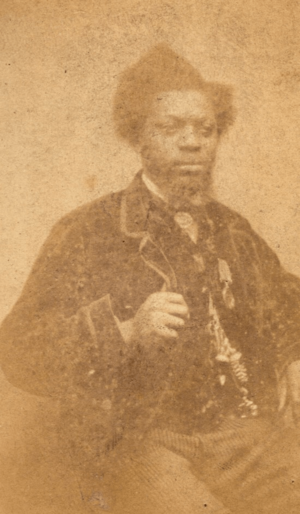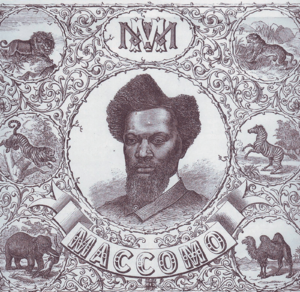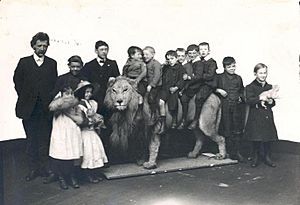Martini Maccomo facts for kids
Quick facts for kids
Martini Maccomo
|
|
|---|---|

Photograph of Maccomo
|
|
| Born | Between 1835 and 1840 Portuguese Angola (reputedly)
|
| Died | 11 January 1871 Sunderland, England
|
| Occupation | Lion tamer |
Martini Maccomo (died 11 January 1871) was a famous lion tamer in Victorian Britain. He performed with William Manders' traveling animal show, called a menagerie, starting around 1854. He was the main attraction of the show until he died. His act was very exciting and dangerous. He would chase lions and tigers around a cage using whips, pistols, and special gloves called knuckledusters.
Newspapers often reported on how dangerous his shows were, especially when animals attacked him. People saw him as a brave and strong performer. He was known for being very calm and brave when he was in the ring with the animals. Outside the ring, he was known for being kind and quiet. Maccomo died in Sunderland in 1871.
Contents
The Life of a Lion Tamer
Early Years and Background
Martini Maccomo was born in Angola, a country in Africa. However, there were different stories about where he came from. Some said he was born Arthur Williams from the West Indies, or that he was a sailor from Liverpool, England. Others even said he was a Zulu warrior.
His exact birth year is also a bit of a mystery. Records show different ages for him, placing his birth sometime between 1835 and 1840.
Becoming a Famous Performer
Maccomo was one of the first black lion tamers known in Britain. It's not fully clear how he started. We know he worked with Hylton's Menagerie in 1853. By 1854, he had joined William Manders' Royal Menagerie, which was also called the Grand National Mammoth Menagerie.
When Manders' show toured Ireland, advertisements called Maccomo the 'Lion King' and 'Lion Hunter'. A writer named Thomas Frost wrote that Maccomo, who was a sailor, came to the menagerie at Greenwich fair. He wanted to work with the animals. Frost said that Manders let Maccomo try performing with the lions. Maccomo showed so much courage that he was hired right away.
Martini Maccomo performed with Manders' menagerie from late 1857 and became their biggest star.
Dangerous Shows and Animal Attacks
People loved to watch Maccomo because his shows were so dangerous. They wanted to see if he would get hurt. Newspapers often wrote about animal attacks on Maccomo.
- In January 1860, during a show in Great Yarmouth, Maccomo accidentally fired his pistol into the audience. A piece of the gun's wadding hit a man's eye, and he lost his sight in that eye.
- In 1861, while performing in Liverpool, a Bengal tigress bit Maccomo's hand. It took about five minutes to free his hand. A keeper had to press a hot iron bar against the tiger's teeth to make her let go. Maccomo's hand was badly cut. People in the audience were amazed by his bravery.
- In 1862, in Norwich, a young lion bit Maccomo's hand and dragged him across the floor. Part of his index finger bone had to be removed.
- He was attacked again by a Bengal tiger in Dalkeith in 1866. Luckily, his injuries were not too serious that time.
In February 1866, William Manders gave Maccomo a gold medal. It said, "Martini Maccomo, 1866. Presented by Williams Manders, Esq., as a reward for bravery, courtesy, and integrity."
In 1869, while performing in Sunderland, Maccomo was attacked by a lion named Wallace. He only escaped by using his brass knuckles. Wallace the lion died in 1875 and was later stuffed by a taxidermist. The Sunderland Museum bought Wallace in 1879, and he has been on display there ever since.
The End of His Life
Martini Maccomo died on January 11, 1871, in Sunderland. He was staying at The Palatine Hotel and died from a sickness called rheumatic fever. His death was unexpected because he was supposed to perform that very day.
He was buried in Bishopwearmouth Cemetery nearby. William Manders, the owner of the menagerie, paid for his gravestone. Today, his grave is in the section with graves from the Commonwealth War Graves Commission. After Maccomo, another lion tamer named Thomas Macarte took his place at Manders' Menagerie. Sadly, Macarte was killed in the ring in January 1872.
His Style and Personality
Advertisements for Manders' shows often gave Maccomo exciting nicknames. They called him "the African Wild Beast Tamer," "Angola's Mighty Czar of All Lion Tamers," and "The Hero of a Thousand Combats."
When he first performed, Maccomo often wore special costumes that looked like stereotypical "African" outfits. This was different from white lion tamers who usually wore military clothes. Later, Maccomo changed his style. He stopped wearing the tunic and headdress and started wearing a suit and a gold watch. Because he was so famous, many people tried to copy his act and his earlier "African" style. His success made lion tamers a very popular part of animal shows in Great Britain.
People said Maccomo was very calm and brave when facing danger. He never let the audience know if he was scared or in pain. A politician and lion tamer named John Clarke said Maccomo was "one of the most intrepid men who ever performed with wild animals." He said that later lion tamers didn't have Maccomo's "coolness and nerve."
Outside the ring, Maccomo was known for being calm and friendly. His obituary, a notice of his death, said that "His quiet, inoffensive disposition had gained him many true friends." Archibald Forbes wrote in 1871 that Maccomo was the most daring man he had ever seen with lions and tigers. He also mentioned that Maccomo believed he would die a violent death and was often badly hurt, but never killed by the animals.




